Instructions to Candidates
- In section B answer question 6 (compulsory) and either question 7 or 8 in the spaces provided after question 8.
- Candidates should answer the questions in English
For Examiner’s Use Only
|
SECTION |
QUESTIONS |
MAXIMUM SCORE |
CANDIDATE SCORE |
|
A |
1 |
||
|
2 |
|||
|
3 |
|||
|
4 |
|||
|
5 |
|||
|
B |
6 |
||
|
7 |
|||
|
8 |
|||
|
TOTAL SCORE |
|||

QUESTIONS
- The diagram below represents the nitrogen cycle.
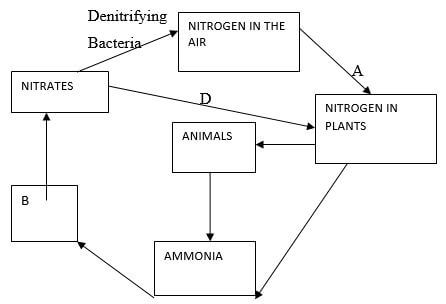
- Name the compound represented by B. (1mark)
- Name the group of organisms represented by E. (1mark)
- State the process labelled A and D. (2 marks)
-
- Name the part of the plant where nitrogen fixation takes place. (1mark)
- What is the effect of denitrifying bacteria in the soil? (1mark)
- How would excess pesticides in the soil interfere with Nitrogen fixation? (2 marks)
- The diagram below shows the results obtained in an experiment on graph of a bean seedling.
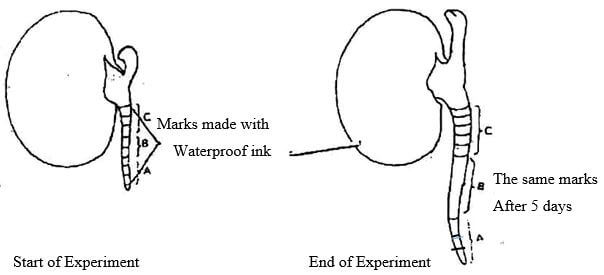
- Suggest the aim of the experiment. (1 mark)
- State the processes that occur in each of the regions marked A, B and C. (3 marks)
- Account for the observations made in the regions A and C. (4 marks)
-
- What is meant by the term linked genes? (1 mark)
- Haemophilia is a genetic condition transmitted through a recessive gene linked to X chromosome. The normal gene may be represented by XH.
- What is the genotype of a haemophilic female? (1 mark)
- A woman who is a carrier for the haemophilia gene marries a normal man. Work out the phenotypic ratio for their offspring. (4 marks)
- Haemophilia is more common in males than in females. Explain this phenomenon. (2 marks)
- A climbing plant twines around the stem of a tall tree.
-
- Name the type of response exhibited by the climbing stem. (1 mark)
- Explain how the response named in (a) (i) above takes place. (3 marks)
- An experiment was carried out to investigate the response of white termites to a certain stimulus. Ten termites were placed at the centre of glass tubing. Calcium chloride was placed one end of the tubing and moist cotton wool at the other end as illustrated below.

- What observations are made after 20 minutes? (1 mark)
- What type of response is exhibited by the termites? (1 mark)
- What is the survival value of the above response? (1 mark)
- What is Photonasty? (1 mark)
-
- A group of students set up the following experiments to investigate the factors that affect enzymes.
Tube 1
Tube 2
Tube 3
Tube 4
Egg white
Amylase/ptyalin at 30o CBoiled starch
Dilute acid
Amylase 360CBoiled starch
AmylaseBoiled starch
Boiled Amylase- Identify the property of enzymes being investigated in tubes 1 and 2 (2 marks)
- After 3 hours thee students tested the content in the four tubes for starch. They obtained the following results in tube 2, 3 and 4.
Tube 2 – Blue – black colour
Tube 3 – Brown colour of iodine remained
Tube 4 – Blues black colour.
Account for the results obtained in tube 3 and 4. (2 marks) - What results would you expect in tube 3 if temperature was maintained at 5oC? Give a reason for your answer. (2 marks)
- Name two enzymes found in the pancreatic juice (3 marks)
SECTION B (40marks)
Answer question 6(compulsory) and either question 7 or 8
- The table below contains information on changes that occur in a river, downstream from a sewage outflow.
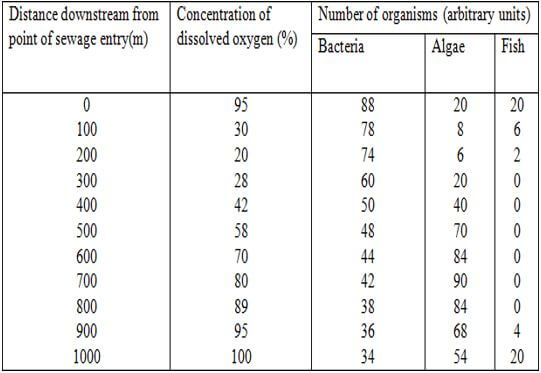
- Plot a graph of number of organisms against distance downstream. (7 marks)

- Describe the changes in the concentration of oxygen dissolved in the water downstream from the point of sewage entry. (2 marks)
- Account for the changes in the numbers of each of the following organisms downstream.
- Bacteria (3 marks)
- Algae (3marks)
- Fish (3marks)
State two ways in which the degree of water pollution caused by sewage can be reduced. (2 marks)
- Plot a graph of number of organisms against distance downstream. (7 marks)
-
- Explain three reasons why plants lacks well developed excretory organs. (3 marks)
- Name three ways in which plants excrete waste products. (3 marks)
- State and explain the economic importance of plants excretory products. (14 marks)
- Describe how the various parts of the human digestive system are adapted to their functions. (20 marks)
MARKING SCHEME
-
- Nitrites; 1 (1mk)
- Nitrifying bacteria 1 / Nitrobacter (any one x 1 = 1mk)
- A – Nitrogen fixation 1 (1mk)
D - Absorption 1 (1mk) -
- Root nodules of leguminous plants 1 rej. roots only. (1mk)
- Makes nitrogen unavailable for absorption by plants. (1mk)
- Excess pesticides kill 1 nitrifying bacteria / nitrobacter / azotobacter which converts nitrogen to nitrates hence reducing nitrates in the soil. 1 (2mks)
-
- To determine region of growth in seedlings/region of division and elongation of the seedling;
- A__________ cell division;
B __________ cell elongation;
C __________ cell differentiation; - Region A: Zone of active cell division by meristematic cell; it is made up of small thin-walled meristematic cells which divide without change in length;
Region C: Made up of large cells undergoing various modifications to form different tissues of the plant;
Cells are already mature hence no growth and no change in distance between markings;
-
- Genes located on the same chromosome and are always transmitted /inherited together;
-
- XhXh;
- Parental genotype XHXh X XHY;
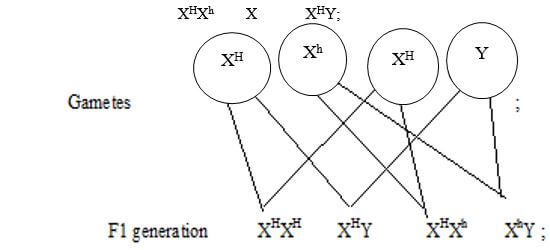
Phenotypic ratio 3 normal: 1 haemophiliac;
NB- Crossing sign must be present
- Circles must be complete
- Fusion lines should not converge or penetrate the gamete.
Accept use of a punnet square
- Males lack corresponding allele on the Y chromosome; therefore they cannot be carriers; OWTTE
-
-
- Name the type of response exhibited by the climbing stem. (1 mark)
- Haptotropism/thigmotropism
- Explain how the response named in (a) (i) above takes place. (3 marks)
- Contact with tree cause auxins to migrate to the side away from contact; causing high concentration this causes faster growth/on that side away; from contact hence the plant twines around the stem;.
- Name the type of response exhibited by the climbing stem. (1 mark)
- An experiment was carried out to investigate the response of white termites to a certain stimulus. Ten termite were placed at the centre of glass tubing. Calcium chloride was placed one end of the tubing and moist cotton wool at the other end as illustrated below.

-
- What observations are made after 20 minutes? (1 mark)
- Most of the termites will have moved towards the end with moist cotton wool.
- What type of response is exhibited by the termites? (1 mark)
- -ve chemotiaxis /+ve hydrotaxis
- What is the survival value of the above response? (1 mark)
- Enable them escape from harmful stimulus/seek favourable habitat;
- What is Photonasty? (1 mark)
- Non-directional movement of parts of plants in response to changes in light intensity;
-
- Tube l – enzyme specificity 1mk
Tube ll- effect of PH on enzyme reactions 1mk - Tube lll – enzyme amylase hydrolyzed starch to reducing sugar; hence no observable change 1mark
Tube lV – Enzymes are denatured by high temperature, hence starch not hydrolyzed 1mark - Iodine solution would turn blue black; Enzyme would be inactive at low temperatures hence starch not hydrolyzed 2marks
-
- pancreatic amylase 1mk
- Trypsin 1mk
- Pancreatic lipase 1mk
- Tube l – enzyme specificity 1mk
-
- Graph: Number of organisms against distance downstream;
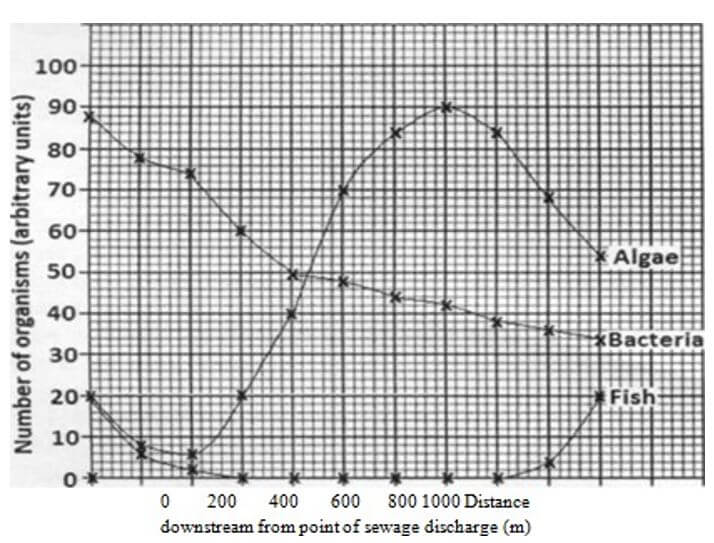
- The concentration of dissolved oxygen decreased; after the point of entry up to 300 m downstream and then increases further downstream; aerobic bacteria uses dissolved oxygen to break down organic matter in sewage; as amount of organic matter in sewage decrease downstream so does the amount of oxygen needed for breakdown;
-
- Initially the bacteria population increases; sewage contain a lot of bacteria and organ matter; bacteria breakdown organic matter and reproduce rapidly; population then decreases downstream as the amount of organic matter decrease downstream;
- Decreases immediately after sewage discharge; organic matter in sewage reduces light penetration hence reduced photosynthesis and growth of algae; Increases later downstream; organic matter in sewage broken down providing excess nutrients leading to eutrophication; later decreases as the algae die due to excess competition;
- Drops sharply and all die within 300 m from point of discharge; decrease in concentration of oxygen leads to death of fish by suffocation; organic matter in sewage clogs gills of fish leading to their death; sewage have toxic chemicals which directly kill fish; fish reappears after 800 m from point of sewage discharge and thereafter increases; amount of organic matter in sewage has decreased hence increasing oxygen concentration; less solid matter to clog fish gills;
- Proper sanitation;Sewage must be purified before it enters the river; Education; to make people aware of proper waste disposal measures Research; - more efficient ways of treating sewage;
- Graph: Number of organisms against distance downstream;
-
- Reasons why plants lack well developed excretory organs
- Metabolic processes in plants occur at a slower rate than in animals;
- Some of the waste products produced in one process are used in another process eg CO2 released during respiration is utilized in photosynthesis;
- Most of the substances that are broken down in plants are carbohydrates in nature. Waste products from carbohydrates are not harmful to the plants;
- Some of the waste products eg resins, gums are stored in dead tissues of plants such as xylem;
- Some plant waste substances that may be toxic to the plant are converted to less harmful substances which are then stored in different parts of the plant such as petals, leaves, fruits and seeds. Some of these plant parts are eventually shed by the plant.
- Methods of Excretion
- Diffusion;
- Transpiration;
- Guttation;
- Exudation;
- Deposition;
- Useful Excretory Products
- Anthocyanin ;
- Gives colour to petals and leaves in plants. These colors are of great aesthetic value and are extracted to make dyes;
- Tannins;
- Tannins are used in the treatment of leather/and manufacture of ink/ used in cosmetics ;eg henna which is a plant extract used to colour the nails, feet and hair.
- Latex;
- Latex from the rubber tree is used to make rubber.
- Gums;
- They are produced by different plants such as arabic, ghath and carob. These gums are edible and are used to thicken food and creams/Sapodilla gum is used in the manufacture of chewing gum;.
- Quinine;
- It’s obtained from the bark of cinchona tree/It’s used in the treatment of malaria/Also its added in drinks as a stimulant;
- Cannabis;
- It’s normally extracted and used in the manufacture of drugs such as painkillers.
- Cocaine;
- It’s used as a local anaesthetic/ It’s addictive when taken in large amounts and can lead to ailments of the heart;
- Nicotine
- Its used to manufacture insecticides/ The tar from the tobacco is poisonous and cause lung cancer in human beings.
- Caffeine;
- It’s a mild stimulant which is refreshing./ It increases mental activity and reduces fatigue./Excessive intake of caffeine can cause sleeplessness and so may cause mental illness./It can cause changes in cells of the foetus/ It increases the activity of adrenaline;
- Morphine;
- It’s also a painkiller and muscle relaxant.
- Papain;
- Its extracted from pawpaw trees and used as a meat tenderiser;.
- Colchicine;
- Its obtained from the roots of crocus plant. Its used to bring about mutation in genetic materials thus useful in plant breeding.
- Its carcinogenic ie it can cause cancer.
- Khat/miraa;
- Its used as a stimulant.
- Pyrithrin;
- Its used to make insecticides;
- Anthocyanin ;
- Reasons why plants lack well developed excretory organs
- Adaptation of various parts of digestive system 20mks
- Mouth;
- Has teeth for chewing to increase the surface area for digestion and easy swallowing
- Has salivary gland which secrete saliva which contain water to soften and mucus lubricate food for easy swallowing
- Has muscular tongue to turn food sideways for proper mixing with saliva and chewing
- Rolls food in to boluses and pushes them down the gullet
- Saliva has saliva amylase to initiate digestion of starch;
- Oesophagus;
- Has circular and longitudinal muscles to propel food in to the stomach by peristalsis
- Stomach;
- Has cardiac sphincter muscles to allow/regulate food entry into the stomach
- Pyloric sphincter to retain food for digestion in the stomach/allow/regulate food entry into duodenum
- Has gastric glands that secrete mucus to protect wall of the stomach from digestive enzymes; enzymes pepsin and rennin to digest proteins;hydrochloric acid to kill bacteria in food;and provide optmum PH for protein digestion,activation of pepsnogen
- Has muscular walls whose contaction churn/mix chyne with digestive enzymes.
- Duodenum
- Has Brunners glands in its walls to produce alkaline fluid and mucus
- Has crypts of lieberkuhn whose cells produce digestive enzymes
- Is connected to the pancrease and the liver which supply pancreatic juice and bile respectively
- Bile emulsifies fats and neutralizes the acid from the stomach. Pancreatic juice contains digestive enzymes/pancreatic lipase, pancreatic amylase and Trypsin that acts on lipids, starch/amylase and proteins respectively.
- Ileum
- Long to allow complete digestion and absorption of food
- Has villi and microvilli to increase surface area for digestion and absorption
- Highly coiled to slow down movement for completion for digestion and absorption
- Narrow to keep digested food in contact with epithelium to reduce distance over which food diffuses
- Has with epithelial cells for faster diffusion
- Highly vascularizerd /large number of capillaries to maintain steep concentration for absorption and transport of food substances
- Has lacteals for absorption of fatty acids and glycerol
- Has muscular walls for peristaltic movement of food
- Colon
- Long to increase surface area for absorption of water and mineral salts
- With muscular walls for peristaltic movement of undigested food
- Rectum;
- Secretes large amounts of mucus for lubrication to aid defecation
- Anus
- With muscular sphincter to control defecation
- Mouth;
Download Biology Paper 2 Questions and Answers - Bunamfan Post Mock 2021 Exams.
Tap Here to Download for 50/-
Get on WhatsApp for 50/-
Why download?
- ✔ To read offline at any time.
- ✔ To Print at your convenience
- ✔ Share Easily with Friends / Students

